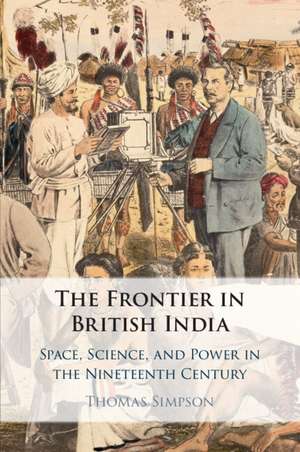The Frontier in British India: Space, Science, and Power in the Nineteenth Century
Autor Thomas Simpsonen Limba Engleză Paperback – 14 dec 2022
| Toate formatele și edițiile | Preț | Express |
|---|---|---|
| Paperback (1) | 206.00 lei 6-8 săpt. | |
| Cambridge University Press – 14 dec 2022 | 206.00 lei 6-8 săpt. | |
| Hardback (1) | 601.91 lei 6-8 săpt. | |
| Cambridge University Press – 6 ian 2021 | 601.91 lei 6-8 săpt. |
Preț: 206.00 lei
Nou
Puncte Express: 309
Preț estimativ în valută:
39.42€ • 41.38$ • 32.72£
39.42€ • 41.38$ • 32.72£
Carte tipărită la comandă
Livrare economică 11-25 aprilie
Preluare comenzi: 021 569.72.76
Specificații
ISBN-13: 9781108794121
ISBN-10: 1108794122
Pagini: 314
Dimensiuni: 229 x 151 x 20 mm
Greutate: 0.42 kg
Editura: Cambridge University Press
Colecția Cambridge University Press
Locul publicării:Cambridge, United Kingdom
ISBN-10: 1108794122
Pagini: 314
Dimensiuni: 229 x 151 x 20 mm
Greutate: 0.42 kg
Editura: Cambridge University Press
Colecția Cambridge University Press
Locul publicării:Cambridge, United Kingdom
Cuprins
Introduction; 1. Borders; 1.1 'Rude and complicated': the posa boundary in northern Assam; 1.2 'Making outside barbarians': the administrative border in early colonial Punjab; 1.3 'Absurd and impossible': bordering the Naga Hills District, 1866–1905; 1.4 'Breaking the border rule': Balochistan's boundaries, 1866–1892; 1.5 'Substantial pillars': marking the boundary in northern Assam during the 1870s; 1.6 'A line shifting': borders in the Chin-Lushai Hills, 1869–1900; 1.7 'As if our territory': British India's international boundaries at the turn of the twentieth century; 1.8 Conclusion: limits of the colonial state; 2. Surveys and maps; 2.1 'Getting at the truth': route surveys at nascent frontiers; 2.2 'Impossible to level': frontiers and the problem of altitude in the 1850s; 2.3 'Rough accurate maps': frontier representations as material objects; 2.4 Sites for 'sore-eyes': surveying in frontier regions from the later 1860s; 2.5 'A higher land': theorising the unknowable frontier; 2.6 Conclusion: 'Clean out of the map'; 3. Ethnography; 3.1 'Entirely distinct from the ordinary population': ethnographic encounters during the 1810s; 3.2 'Raising, not solving, doubts': the advent of Assam's 'mountain tribes', 1820s–1840s; 3.3 'Aboriginal remnants': ethnography in the time of war and annexation at the Sind and Punjab frontiers, 1830s–1850s; 3.4 'Patient, painstaking care': fragmented ethnography in northeast India during the 1870s; 3.5 'Insufficient intimacy and confidence': photographing 'frontier tribes' in the later nineteenth century; 3.6 'Purely tribal': frontiers and anthropology at the turn of the twentieth century; 3.7 Conclusion: productive problems; 4. Violence; 4.1 'Terrible to behold': violence on the Upper Sind frontier, 1839–1848; 4.2 'Often repeated outrage': state violence and the Nagas, 1838–1900; 4.3 'Few permanent results': military expeditions on the Punjab frontier, 1849–1901; 4.4 Conclusion: 'Exterminate all the brutes'; 5. Administration; 5.1 'Strangers and exiles': tribal colonies on the Upper Sind Frontier; 5.2 'Made very useful': relocating communities in northeastern Assam; 5.3 'Doing nothing but write-write-write': irregular administration at the northeast frontier; 5.4 'A rough half-subdued country': administering Balochistan, 1877–1900; 5.5 Conclusion: Fashioning fractals; Conclusion: the significance of the frontier in British India.
Recenzii
'The Frontier in British India is an engaging, insightful and lucid exploration of British India's Northwest and Northeast frontier regions. Drawing on a remarkable range of sources, Thomas Simpson illuminates the inconsistencies, anxieties and internal debates that characterised British colonial approaches to the frontiers of India. Going beyond conventional approaches that have emphasised the progressive systematisation of colonial attempts to govern, classify and subdue frontier territories, Simpson emphasises the significance of 'the man on the spot', the forms of personal power, authority and violence such characters exercised, and the debates they stimulated in imperial metropoles.' Magnus Marsden, University of Sussex
'Maintenance of frontiers has long been decisive in national and imperial histories. This cleverly-argued and brilliantly-illustrated study challenges such assumptions. In fascinating cases of conflict and encounter, this book demonstrates that in the highland borderlands of nineteenth-century south Asia absence of control and fluidity of command generated opportunities for trade, improvisation and negotiation. This timely history of British India's borderlands will help change images of empire and colony, and of indigenous agency and culture.' Simon Schaffer, University of Cambridge
'… stimulating … This volume should appeal not just to historians of India and empire but also to students of geography and cartography.' Thomas R. Metcalf, Journal Of Interdisciplinary History
'… Simpson (geography, Univ. of Cambridge, UK) combines both fields of study in this well-researched work, drawing on historical, geographical, and anthropological approaches to produce a study of northwest and northeast India that expands current understandings of this region … This fine study balances a look at the old figures of empire with the popular notion of indigenous agency. Recommended.' R. D. Long, Choice Connect
'Maintenance of frontiers has long been decisive in national and imperial histories. This cleverly-argued and brilliantly-illustrated study challenges such assumptions. In fascinating cases of conflict and encounter, this book demonstrates that in the highland borderlands of nineteenth-century south Asia absence of control and fluidity of command generated opportunities for trade, improvisation and negotiation. This timely history of British India's borderlands will help change images of empire and colony, and of indigenous agency and culture.' Simon Schaffer, University of Cambridge
'… stimulating … This volume should appeal not just to historians of India and empire but also to students of geography and cartography.' Thomas R. Metcalf, Journal Of Interdisciplinary History
'… Simpson (geography, Univ. of Cambridge, UK) combines both fields of study in this well-researched work, drawing on historical, geographical, and anthropological approaches to produce a study of northwest and northeast India that expands current understandings of this region … This fine study balances a look at the old figures of empire with the popular notion of indigenous agency. Recommended.' R. D. Long, Choice Connect
Notă biografică
Descriere
An innovative account of how distinctive forms of colonial power and knowledge developed at the territorial fringes of colonial India.
